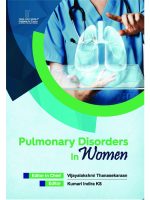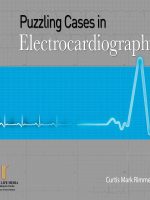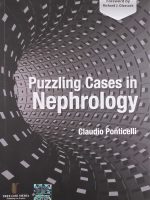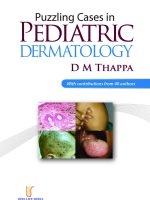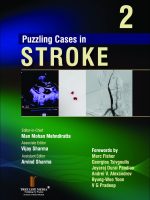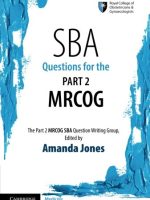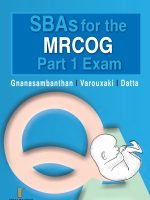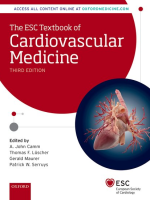Recommended Books
-
Pulmonary Disorders in Women
₹1,695.00This is a book reflecting women’s perspectives in lung disorders. It is an evolving concept that all systems of the body have sex-specific biological features. It is often observed that the etiology, clinical course ans response to treatment of many diseases vary between men and men. These differences are due to the differences in genes, and due to the differential exposure of hormones and environmental factors starting from the prenatal period. This is why, male and female tissues behave differently in many respects. However, sex-specific approach is not considered in majority of the situations other than for women – specific diseases. Women have different gender-specific roles in the society and hence the epidemiological and demographic characteristics of many diseases vary between men and men. Gender differences between men and women in compliance to treatment and health seeking behaviors may be major contributors of gender specific epidemiological trends.
-
PULMONARY MEDICINE COMMON AND UNCOMMON CASES
₹1,295.00Common and Uncommon Cases in Pulmonary Medicine bring to the readers real time clinical case ranging from common diseases with typical presentations to uncommon and rare diseases with atypical features. Presented in a comprehensive, easy to read format, the book aims to be extremely useful to pinpoint a diagnosis. The chest X-ray is often central to the diagnosis and management of a patient. As a result, every doctor requires a thorough understanding of the common radiological problems. This pocket book describes the range of conditions likely to be encountered in the day-to-day clinical practice and guides the reader through the diagnostic process based on the appearance of the abnormality shown. Salient Features – Detailed discussion on X-ray and CT scans providing a clear understanding of a range of diseases encountered. – Includes valuable advice on how to examine an X-ray. – Assists the doctor in determining the nature of the abnormality. – Points the clinician towards a possible differential diagnosis. – Clinical pointers in each chapter to note the important features that may be missed. – There is extended use of CT imaging with advice on choosing modalities depending on the clinical circumstances.
-
Puzzling Cases in Electrocardiography
₹775.0012 Lead Electrocardiography remains as clinically relevant now as when first introduced to clinical medicine decades ago. The value of 12 Lead ECG is mattering the ability to integrate the ECG findings into information provided by the history and Physical Examination. The book authored by Prof Rimmerman, one of the foremost Cardiologists in the world follows 50 ECG Case Studies purposefully chosen where the ECG made a clinical impact on the management of the patient
-
Puzzling Cases in Nephrology
₹2,295.00This Unique book provides a glimpse of how medical mysteries can be solved, or if not solved, atleast better understood. There is much in this book that will not easily be found in modern textbooks, as this to me organizes information around case examples rather than organizing facts around disease entities. In this book cases of renal diseases and kidney transplantation of particular diagnostic or therapeutic interest have been selected. This is an essential read for Nephrologists in practice and training and all those interested in care for a Renal patient
-
Puzzling Cases in Otolaryngology
₹795.00It is a well-known fact that only if you are aware that a certain disease exists, are there chances that it will be diagnosed correctly when it is encountered. The purpose of this book is to remind the clinician of the existence of various conditions and the multitudinous ways they manifest themselves. Case reports are still important reminders of how diseases present in different ways that can confound the clinician.The case reports in this book aptly illustrate this. They are complied by experts from all around the globe. It is our endeavor to empower those who read this book to better understand the various manifestations of diseases and how to better diagnose, evaluate and treat these problems.
-
Puzzling Cases in Pancreatic Diseases
₹675.00Pancreatology, as a discipline, has not been in focus for long has become a vanishing specialty for a variety of reasons. As a consequence, pancreatologists face several issues despite the ongoing their e orts in managing their practice and maintaining their identity in the fraternity. e changes in medical practice in many parts of the world have led to a shift of responsibilities, away from the surgeon and towards the gastroenterologist. e latter may not be equipped with su cient resources to acquire the knowledge. While the mainstream issues in pancreatology are taught at various levels and conferences, as well as guidelines, the remaining is mostly left to the experts, not to say connoisseurs. A selection of such experts from around the globe have contributed to this book with very special cases and exemplifying problems in the form of case reports for better application and understanding of the same in clinical practice. Medical journals in the hunt for their respective impact factors have stopped publishing case reports as these cannot be cited, therefore other channels become imperative to impart this knowledge to the medical community. Puzzling Cases in Pancreatic Diseases is a logical initiative in this direction. A good deal can be learned from these case reports that are professionally presented and discussed.
-
Puzzling Cases in Pediatric Dermatology Volume 1
₹995.00The book covers 30 Unique Cases in Pediatric Dermatology written by some of the Leading Experts. The book would be highly useful to all Dermatologists, Pediatricians, Consulting Physicians, Post Graduate Students and those interested in treating Children with Dermatological Conditions
-
Puzzling Cases in Stroke
₹1,250.00Stroke is the leading cause of permeant disability , including post stroke dementia, pain, depression and personality changes. While large Clinical Trials reflect information about large stroke populations, the presentation of each and every stroke patient is individual and special. Currently there are only few books which illustrate case oriented discussion. This is unique book which includes common and unusual case of stroke, so as to reinforce diagnostic skills through careful analysis of individual presenting patterns, and to guide treatment decisions.
-
Puzzling Cases in Stroke Vol. 2
₹1,695.00Stroke is a treatable medical emergency affecting about 15 million people every year worldwide. It is the most common cause of common cause of disability globally and is the third most common cause of death. In the present times, there are effective treatment options which if given timely will benefit the patients of stroke remarkably. Therefore, correct diagnosis of acute stroke is extremely important for the clinicians to provide appropriate treatments and to ensure prevention of acute complications, including recurrent strokes. But sometimes a typical or uncommon presentation of stroke or “stroke chameleons”can lead to diagnostic dilemma. Therefore, timely diagnosis and management may be delayed. There are time – tested strategies which when strictly followed by the Neurphysician can reduce the chances of missing the correct diagnosis. Firstly, “Listen very carefully to the patient. He is telling you the diagnosis.” Clinicians should suspect stroke when the history suggests abrupt onset of neurological symptoms. Remember, Stroke is a clinical diagnosis and imaging is providing the corroboratory evidence. Secondly, a complete and systematic neurological examination should be routinely done in patients presenting with acute neurological symptoms because this might shed light on the true nature of the problem. Finally, even the most sophisticated neuroimaging tests might miss the stroke in the early hours after the event.
-
-
Textbook and Atlas of Dermatology 2nd Ed.
₹3,995.00Salient Features :
1) Comprehensive visual guidance you need to effectively evaluate, diagnose and manage all forms of skin disease. over 200 images richly depict etiology, clinical features, diagnosis and treatment, equipping you to provide the best care to every patient. 2) More than 40 chapters covering all dermatological ailments. 3) More than 200 illustrations from the Author’s personal database giving a unique overview of the diseases. 4) Hands – on clinical experience sharing in the form of cases, clinical presentations and management approach.
-

